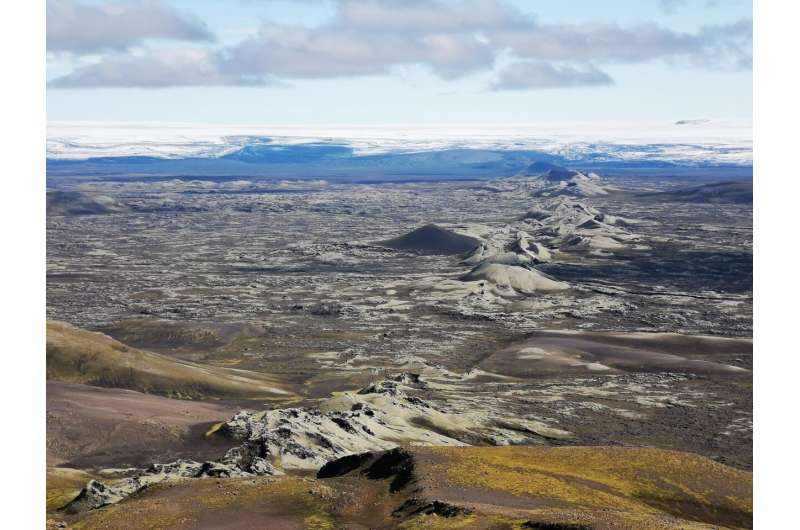Researchers reconstruct Earth’s carbon cycle using thermodynamic modeling and plate tectonic reconstructions
Researchers from the School of Earth Sciences at The University of Western Australia have helped reconstruct the cycle of carbon in the Earth using thermodynamic modeling and plate tectonic reconstructions dating back 250 million years.
Research Fellows Dr. Weronika Gorczyk, from the Centre for Exploration Targeting, and Dr. Christopher Gonzalez, from the Centre for Data-driven Geosciences, were co-authors on “Evolution of Earth’s tectonic carbon conveyor belt,” published in Nature.
Plate tectonics is a unique process to our planet that slowly shifts around the Earth’s crust. It is responsible for the formation of the land we live on today including creating mountains, generating earthquakes and activating volcanoes.
Over time downward movement of the plate on the Earth’s crust brings carbon down deep into the Earth and facilitates its return to the surface at mid-ocean ridges and volcanic arcs.
The process is cyclical and plays a pivotal role in Earth’s climate and habitability, the evolution of life, as well as diamond and ore formation.
Dr. Gonzalez said the study had changed how we could think about and quantify the Earth’s important chemical reservoirs.
“Previously, the view was that carbon outgassing was solely driven by plate tectonics,” Dr. Gonzalez said.
“This work challenges that view, showing the critical role sedimentological processes can have on carbon recycling during certain periods in Earth’s history when coupled with plate tectonics.”
Dr. Gorczyk said the new modeling shed a light on not only the planetary cycles of carbon but also other elements such as strontium, uranium, rare-earth elements and gold.
“In the future this may enable more targeted exploration and therefore lower the environmental footprint,” Dr. Gorczyk said.
“The Earth carbon cycles have complex influence of atmospheric CO2, long-term climate variability and in turn evolution of life and precipitation of carbonate.”
Earliest geochemical evidence of plate tectonics found in 3.8-billion-year-old crystal
R. Dietmar Müller et al, Evolution of Earth’s tectonic carbon conveyor belt, Nature (2022). DOI: 10.1038/s41586-022-04420-x
Citation:
Researchers reconstruct Earth’s carbon cycle using thermodynamic modeling and plate tectonic reconstructions (2022, May 26)
retrieved 26 May 2022
from https://phys.org/news/2022-05-reconstruct-earth-carbon-thermodynamic-plate.html
This document is subject to copyright. Apart from any fair dealing for the purpose of private study or research, no
part may be reproduced without the written permission. The content is provided for information purposes only.

Researchers from the School of Earth Sciences at The University of Western Australia have helped reconstruct the cycle of carbon in the Earth using thermodynamic modeling and plate tectonic reconstructions dating back 250 million years.
Research Fellows Dr. Weronika Gorczyk, from the Centre for Exploration Targeting, and Dr. Christopher Gonzalez, from the Centre for Data-driven Geosciences, were co-authors on “Evolution of Earth’s tectonic carbon conveyor belt,” published in Nature.
Plate tectonics is a unique process to our planet that slowly shifts around the Earth’s crust. It is responsible for the formation of the land we live on today including creating mountains, generating earthquakes and activating volcanoes.
Over time downward movement of the plate on the Earth’s crust brings carbon down deep into the Earth and facilitates its return to the surface at mid-ocean ridges and volcanic arcs.
The process is cyclical and plays a pivotal role in Earth’s climate and habitability, the evolution of life, as well as diamond and ore formation.
Dr. Gonzalez said the study had changed how we could think about and quantify the Earth’s important chemical reservoirs.
“Previously, the view was that carbon outgassing was solely driven by plate tectonics,” Dr. Gonzalez said.
“This work challenges that view, showing the critical role sedimentological processes can have on carbon recycling during certain periods in Earth’s history when coupled with plate tectonics.”
Dr. Gorczyk said the new modeling shed a light on not only the planetary cycles of carbon but also other elements such as strontium, uranium, rare-earth elements and gold.
“In the future this may enable more targeted exploration and therefore lower the environmental footprint,” Dr. Gorczyk said.
“The Earth carbon cycles have complex influence of atmospheric CO2, long-term climate variability and in turn evolution of life and precipitation of carbonate.”
Earliest geochemical evidence of plate tectonics found in 3.8-billion-year-old crystal
R. Dietmar Müller et al, Evolution of Earth’s tectonic carbon conveyor belt, Nature (2022). DOI: 10.1038/s41586-022-04420-x
Citation:
Researchers reconstruct Earth’s carbon cycle using thermodynamic modeling and plate tectonic reconstructions (2022, May 26)
retrieved 26 May 2022
from https://phys.org/news/2022-05-reconstruct-earth-carbon-thermodynamic-plate.html
This document is subject to copyright. Apart from any fair dealing for the purpose of private study or research, no
part may be reproduced without the written permission. The content is provided for information purposes only.
